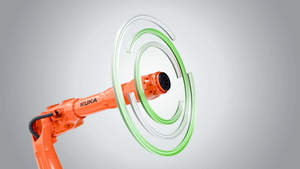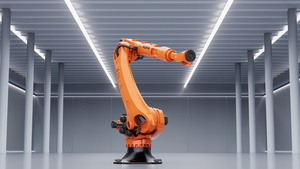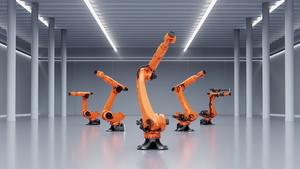
 |
Charlotte Stonestreet
Managing Editor |
| Home> | AUTOMATION | >Robots | >Sustainable transformation – a path to the future |
Editor's Pick
Sustainable transformation – a path to the future
10 June 2025
In a world increasingly characterised by ecological challenges, industry plays a decisive role in shaping a sustainable future. Neil Mead looks at how KUKA is driving forward the circular economy, optimising the energy efficiency of its robots.

KUKA IS constantly working to improve energy efficiency and is committed to establishing a circular economy for its robots. This means that as soon as a robot system has reached the end of its lifecycle, recyclable services come into play, allowing valuable resources from these devices to be reused and CO2 emissions to be reduced. The most energy-efficient method of utilising used automation products is to refurbish a robot for a new task in a production environment. After several test runs, a refurbished robot system that is as good as new can then resume its work. Product safety during operation is guaranteed by standard warranty agreements. This enables a low-cost entry into automation and makes an important contribution to environmental and climate protection.
Circular services
If a robot can’t be reused as a whole, a check is made to see which parts can be reprocessed and reused in second-hand robots. Recycling aluminium requires only about five percent of the energy that would be needed for primary production - a benefit for the environment, as mining the bauxite ore destroys large areas of land. The production of steel, a main component of robots, also requires large amounts of energy. KUKA's approach here is to use the material for as long as possible and return it to new product manufacture through recycling.
By increasing the efficiency of its products, KUKA is simultaneously saving energy and costs: new, more economical robots mean that customers spend less on energy and the climate is protected in the long term. The savings potential is enormous, with energy consumption accounting for up to 40 percent of the total cost of ownership of a robotic product. KUKA developers optimise energy efficiency primarily through these three factors:
- Weight and design: The slim design of the robot mechanics reduces energy consumption and the use of materials.
- Hardware: Robot controllers with energy-efficient components and algorithms ensure up to 60 percent less energy consumption compared to previous models.
- Software: Intelligent path planning, optimised movement behaviour and energy-saving options (e.g. ECO mode) also reduce energy consumption.
These measures have enabled the latest KR FORTEC robot to reduce energy consumption by 35 percent compared to the previous generation, for example. These more efficient robotic products make it easier for KUKA customers to achieve their sustainability goals. In addition, simulation tools from KUKA make it possible to virtually simulate the consumption of production systems as early as the planning phase. This means that every customer can be offered the right sustainable concept at an early stage.
Digital tools
Digitalisation offers many opportunities to work more sustainably. To this end, KUKA and Device Insight have developed the KUKA iiQoT tool (based on the Industrial Internet of Things), which helps customers use their robot fleet transparently and efficiently. With its condition monitoring feature, the software makes it possible to constantly remotely monitor the condition of the robot, identify faults at an early stage, and thus prevent damage. Combined with proactive maintenance intervals through the option of predictive maintenance, the lifecycle of the robot can be extended - an important contribution to sustainable working.
KUKA has formulated clear corporate goals towards climate protection, including a 40-percent reduction of CO₂ emissions by 2030. The comprehensive sustainability management aims to continuously improve energy and resource efficiency and minimise the ecological footprint at all production sites. For example, KUKA is already generating some of its electricity through the operation of photovoltaic systems, and by 2030, all branches are to be supplied entirely with renewable energy. Additionally, the entire company car fleet is to be electrified and thus CO2-neutral by 2030. KUKA is already using 150 charging stations at its Augsburg site and the headquarters are supplied with environmentally friendly district heating.
KUKA has also significantly reduced the material used for packaging. For example, the material thickness of the PE film has been almost halved from 120 to 65µm. This corresponds to a saving in plastic consumption by KUKA of around ten tons per year. Furthermore, reusable plastic crates are now used for shipping instead of disposable packaging. This reduces the company's plastic consumption further by two tons per year and paper consumption by 23t per year.
Neil Mead is marketing and strategy director business segment robotics at KUKA Robotics UK
To find out more about KUKA’s sustainable transformation, head to:
- Balls to Gravity
- ROBOTS GIVE FASTER CELL TOOL CHANGE TIMES
- ROBOT FOR DELICATE ASSEMBLY
- NUMBER OF ROBOTS IN UK ON THE RISE
- The future is bright - The future is automation!
- High Demand For Grant
- More Capacity, Less Space
- FREEBIRD - THE THIRD DIMENSION
- PRECISION ROBOT CELL FOR THE PHARMACEUTICAL INDUSTRY
- ROBOT SALES REACH ALL TIME HIGH





















